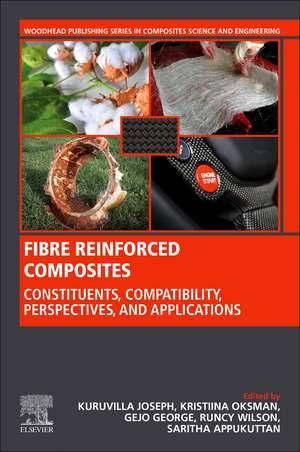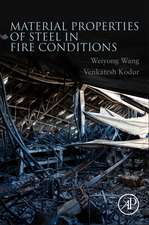Fiber Reinforced Composites: Constituents, Compatibility, Perspectives and Applications: Woodhead Publishing Series in Composites Science and Engineering
Editat de Kuruvilla Joseph, Kristiina Oksman, George Gejo, Runcy Wilson, Saritha Appukuttanen Limba Engleză Paperback – 22 mar 2021
Fibre Reinforced Composites: Constituents, Compatibility, Perspectives and Applications presents a widespread all-inclusive review on fibre-reinforced composites ranging from the different types of processing techniques to chemical modification of the fibre surface to enhance the interfacial adhesion between the matrix and fibre and the structure-property relationship. It illustrates how high value composites can be produced by efficient and sustainable processing methods by selecting different constituents [fibres and resins]. Researchers in academia working in composites and accompanying areas [materials characterisation] and industrial manufacturers who need information on composite constituents and how they relate to each other for a certain application will find the book extremely useful when they need to make decisions about materials selection for their products.
- Focuses on the different types of FRC’s that are currently available (e.g. from polymeric matrices to metallic and ceramic matrices, from carbon fibre to different types of natural fibres and from short to long fibre reinforced), their processing techniques, characterization of different properties, and how to improve the interfacial adhesion between an incompatible fibre and matrix and their applications
- Looks at crisis areas such as how to incorporate incompatible fibres and matrices together (e.g. Non-polar polypropylene matrix is not compatible with that of polar natural fibres and hence suitable surface modifications are required to make them compatible with each other) along with low cost processing methods, low density and high strength
- Uncovers clarifications to both elementary and practical problems related to the fabrication of FRCs
- Schematic representations depicting the interaction between different fibre types and matrices will be provided in some chapters
Din seria Woodhead Publishing Series in Composites Science and Engineering
- 29%
 Preț: 1153.66 lei
Preț: 1153.66 lei - 29%
 Preț: 1477.86 lei
Preț: 1477.86 lei - 24%
 Preț: 1160.48 lei
Preț: 1160.48 lei - 39%
 Preț: 1153.30 lei
Preț: 1153.30 lei - 24%
 Preț: 1451.12 lei
Preț: 1451.12 lei - 9%
 Preț: 1019.80 lei
Preț: 1019.80 lei - 29%
 Preț: 1129.94 lei
Preț: 1129.94 lei - 9%
 Preț: 1049.32 lei
Preț: 1049.32 lei - 29%
 Preț: 1067.77 lei
Preț: 1067.77 lei - 9%
 Preț: 1069.37 lei
Preț: 1069.37 lei - 29%
 Preț: 1326.23 lei
Preț: 1326.23 lei - 29%
 Preț: 1243.53 lei
Preț: 1243.53 lei - 29%
 Preț: 1213.41 lei
Preț: 1213.41 lei - 39%
 Preț: 1155.04 lei
Preț: 1155.04 lei - 9%
 Preț: 1006.50 lei
Preț: 1006.50 lei - 29%
 Preț: 1067.31 lei
Preț: 1067.31 lei - 9%
 Preț: 1140.31 lei
Preț: 1140.31 lei - 24%
 Preț: 1130.30 lei
Preț: 1130.30 lei - 9%
 Preț: 1069.99 lei
Preț: 1069.99 lei - 24%
 Preț: 1130.20 lei
Preț: 1130.20 lei - 9%
 Preț: 904.59 lei
Preț: 904.59 lei - 23%
 Preț: 999.51 lei
Preț: 999.51 lei - 9%
 Preț: 1542.98 lei
Preț: 1542.98 lei - 23%
 Preț: 992.64 lei
Preț: 992.64 lei - 9%
 Preț: 1210.03 lei
Preț: 1210.03 lei - 9%
 Preț: 1328.05 lei
Preț: 1328.05 lei - 24%
 Preț: 1563.73 lei
Preț: 1563.73 lei - 24%
 Preț: 1159.26 lei
Preț: 1159.26 lei - 24%
 Preț: 1559.63 lei
Preț: 1559.63 lei - 9%
 Preț: 1212.62 lei
Preț: 1212.62 lei - 29%
 Preț: 1158.40 lei
Preț: 1158.40 lei - 28%
 Preț: 1075.60 lei
Preț: 1075.60 lei - 29%
 Preț: 1158.75 lei
Preț: 1158.75 lei - 29%
 Preț: 925.09 lei
Preț: 925.09 lei - 29%
 Preț: 1417.65 lei
Preț: 1417.65 lei - 9%
 Preț: 989.97 lei
Preț: 989.97 lei - 29%
 Preț: 1479.85 lei
Preț: 1479.85 lei - 9%
 Preț: 1335.20 lei
Preț: 1335.20 lei - 29%
 Preț: 1189.81 lei
Preț: 1189.81 lei - 9%
 Preț: 1069.82 lei
Preț: 1069.82 lei - 33%
 Preț: 946.33 lei
Preț: 946.33 lei - 24%
 Preț: 955.72 lei
Preț: 955.72 lei - 29%
 Preț: 1186.95 lei
Preț: 1186.95 lei - 29%
 Preț: 1393.64 lei
Preț: 1393.64 lei - 9%
 Preț: 1011.50 lei
Preț: 1011.50 lei - 9%
 Preț: 1071.27 lei
Preț: 1071.27 lei - 24%
 Preț: 1234.77 lei
Preț: 1234.77 lei - 9%
 Preț: 1208.48 lei
Preț: 1208.48 lei - 9%
 Preț: 1308.84 lei
Preț: 1308.84 lei - 29%
 Preț: 1311.49 lei
Preț: 1311.49 lei
Preț: 1426.19 lei
Preț vechi: 1865.93 lei
-24% Nou
Puncte Express: 2139
Preț estimativ în valută:
272.89€ • 284.93$ • 225.86£
272.89€ • 284.93$ • 225.86£
Carte tipărită la comandă
Livrare economică 29 martie-12 aprilie
Preluare comenzi: 021 569.72.76
Specificații
ISBN-13: 9780128210901
ISBN-10: 0128210907
Pagini: 906
Ilustrații: 220 illustrations (20 in full color)
Dimensiuni: 152 x 229 mm
Greutate: 1.19 kg
Editura: ELSEVIER SCIENCE
Seria Woodhead Publishing Series in Composites Science and Engineering
ISBN-10: 0128210907
Pagini: 906
Ilustrații: 220 illustrations (20 in full color)
Dimensiuni: 152 x 229 mm
Greutate: 1.19 kg
Editura: ELSEVIER SCIENCE
Seria Woodhead Publishing Series in Composites Science and Engineering
Public țintă
Scientists/Researchers working in the field of fibre reinforced composites; Research laboratories, Polymer Scientists, Polymer Chemists, Polymer Engineers, Composite Panel manufacturing companies and R&D’s, Automobile, aerospace companies and their R&D’s dedicated to the use of fibre reinforced panels in different applications.Cuprins
1. An introduction to fibre reinforced composite materials
2. Various fabrication methods employed in fiber reinforced composites
3. Surface treatments in fibre reinforced composites
4. Machining of Composite Materials
5. Thermoplastic natural fibre based Composites
6. Biobased polyamide reinforced with natural fibre composites
7. Elastomer matrix based natural fibre composites
8. Thermosetting natural fibre based composites
9. Polymer Blend Natural Fibre based Composites
10. Biodegradability studies of lignocellulosic fiber reinforced composites
11. Carbon and Glass Fiber Reinforced Thermoplastic Matrix Composites
12. Carbon fiber and Glass fiber reinforced elastomeric composites
13. Thermosetting matrix-based glass and carbon fibre composites
14. Recent toughening strategies in carbon fibre reinforced composites
15. Commingled composites
16. Hollow fibre reinforced polymer composites
17. Metal fibre reinforced composites
18. Aramid fibre reinforced composites
19. Recycling of fibre reinforced thermosetting composites
20. Fibre reinforced cement-based composites
21. Fibre reinforced metal matrix composites
22. Continuous Fibre reinforced ceramic matrix composites
23. Industrial and biomedical applications of fibre reinforced composites
24. Automotive and construction applications of fibre reinforced composites
25. Fiber reinforced composites for aerospace and sports applications
2. Various fabrication methods employed in fiber reinforced composites
3. Surface treatments in fibre reinforced composites
4. Machining of Composite Materials
5. Thermoplastic natural fibre based Composites
6. Biobased polyamide reinforced with natural fibre composites
7. Elastomer matrix based natural fibre composites
8. Thermosetting natural fibre based composites
9. Polymer Blend Natural Fibre based Composites
10. Biodegradability studies of lignocellulosic fiber reinforced composites
11. Carbon and Glass Fiber Reinforced Thermoplastic Matrix Composites
12. Carbon fiber and Glass fiber reinforced elastomeric composites
13. Thermosetting matrix-based glass and carbon fibre composites
14. Recent toughening strategies in carbon fibre reinforced composites
15. Commingled composites
16. Hollow fibre reinforced polymer composites
17. Metal fibre reinforced composites
18. Aramid fibre reinforced composites
19. Recycling of fibre reinforced thermosetting composites
20. Fibre reinforced cement-based composites
21. Fibre reinforced metal matrix composites
22. Continuous Fibre reinforced ceramic matrix composites
23. Industrial and biomedical applications of fibre reinforced composites
24. Automotive and construction applications of fibre reinforced composites
25. Fiber reinforced composites for aerospace and sports applications
















